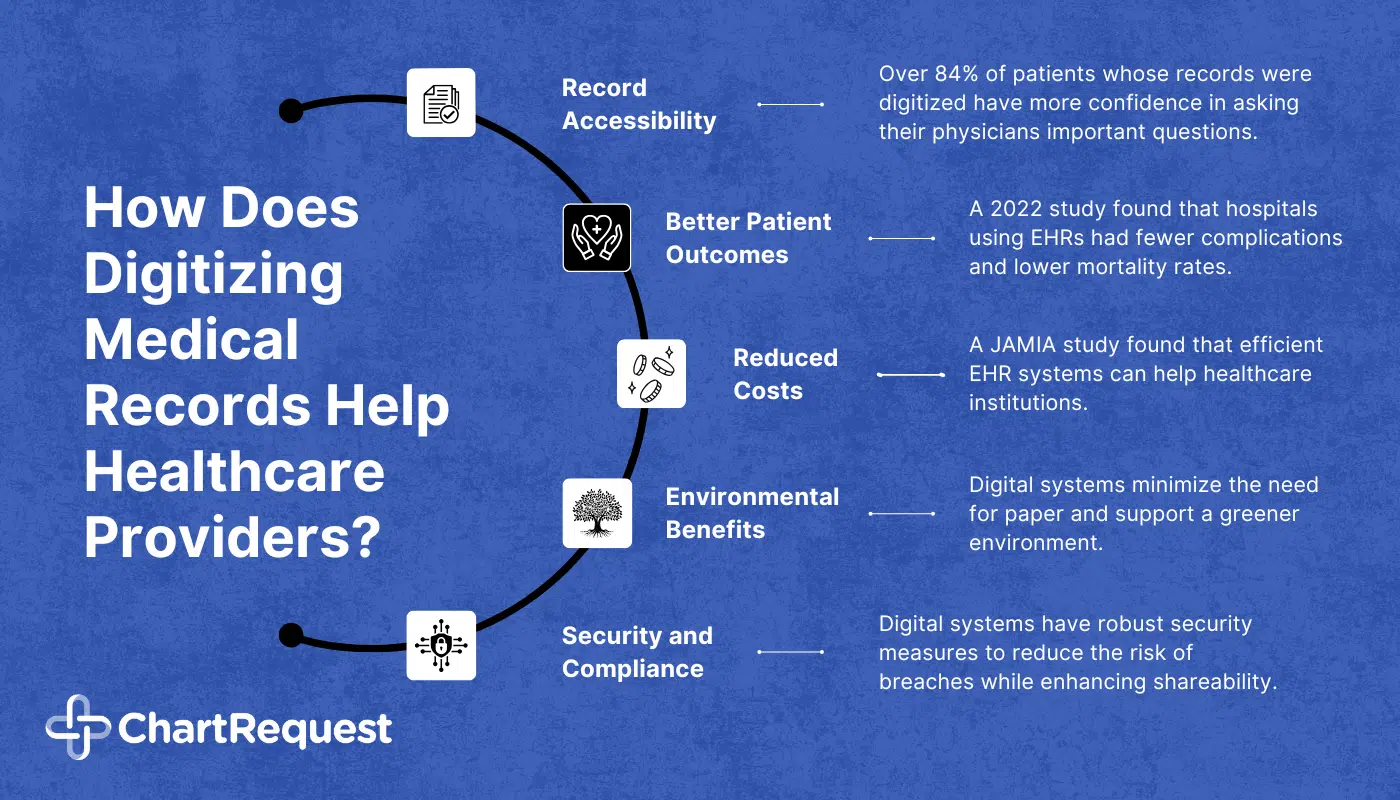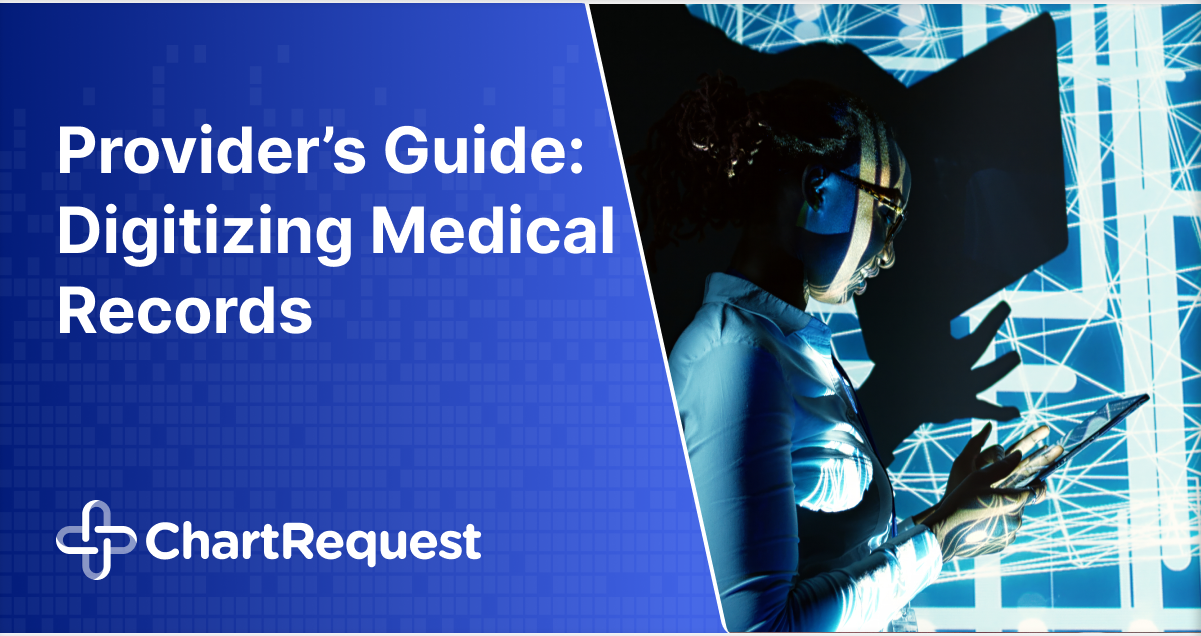Feeling overwhelmed by the administrative burden of paper-based record-keeping? Let’s explore ways digitizing medical records can help you save time and relieve stress.
Just a few decades ago, providers often kept large rooms dedicated to storing paper medical records. Retrieving a single file from these rooms could take hours or even days.
Today, over 96% of hospitals in the US have adopted an Electronic Health Record (EHR) system, compared to just 9% in 2008. This upward trend indicates a clear move towards embracing technology, and the global healthcare IT market is expected to reach $822.5 Billion by 2030.
This transformation to digital medical records isn’t merely a format change; it embodies a broader commitment to patient-centric care and operational efficiency.
The Shift Towards Electronic Health Records (EHRs)
Historically, healthcare operated predominantly on paper. Charts, diagnoses, and treatment plans took up physical space, which made it difficult to access and share them.
By the early 2000s, the healthcare industry started recognizing the limitations of paper-based systems and began transitioning toward digitizing medical records.
The HITECH Act of 2009 promoted the adoption and meaningful use of health information technology. This sped up the digitization of medical records by offering financial incentives for healthcare providers to meaningfully use EHRs.
Today, most medical records are digital, and healthcare providers can coordinate care without using outdated tech like fax machines.
Top 5 Benefits of Digitizing Medical Records
The transition from paper-based to digital systems in the healthcare sector has had a transformative impact. Digitizing medical records is a necessity that brings various advantages.

Here are the top 5 benefits with compelling statistics:
- Enhanced accessibility and sharing: With digital records, healthcare professionals can quickly access patient information from anywhere. Over 84% of patients whose records were digitized have more confidence in asking their physicians important questions.
- Improved patient outcomes: Digital records enable real-time updates and seamless sharing. This results in reduced medical errors. Research revealed that hospitals using advanced EHRs had fewer complications and lower mortality rates.
- Cost efficiency: By eliminating physical storage and reducing administrative tasks, hospitals can save significantly. A study published on the NIH website highlights that efficient EHR systems can result in net savings for healthcare institutions.
- Eco-friendly approach: Hospital systems can print millions of pages per month. Digital systems minimize the need for paper and support a greener environment.
- Enhanced security and compliance: Digital systems have robust security measures to reduce the risk of breaches while enhancing shareability.
The benefits of digitizing medical records extend beyond convenience. This process enhances every facet of healthcare, from patient care to operational efficiency.
Overcoming Challenges in Digitization
While digitizing medical records offers plenty of benefits, the transition isn’t without its challenges. Healthcare organizations may face barriers in their journey toward digital transformation, such as:
- Data Security and Privacy Concerns: A significant concern for many organizations is ensuring the protection of patient data. Roughly 95% of the US population had their medical information disclosed between 2009 and 2021. This alarming number illustrates the need for robust security protocols.
- Interoperability Issues: One of the biggest challenges is moving data between incompatible EHR systems. This creates data silos in healthcare, which complicates care coordination.
- Change Management: Shifting from traditional to digital record-keeping requires training staff to use the new system. Helping your team understand the benefits can reduce friction and promote a positive change experience.
- Cost Implications: Transitioning to digital systems requires an upfront investment, but the time savings of digitizing medical records justifies the initial cost.
It’s important to take a proactive approach to these challenges to fully adapt to the digitalization of medical records. Healthcare facilities can leverage the full potential of digitization by using the right tools, strategies, and a forward-thinking mindset.
What is The Process of Digitizing Medical Records?
Digitizing medical records is a process. It converts paper documents into a digital format. This makes storage, access, and sharing easier.
The procedure typically involves:
- Scanning: Physical documents are scanned using specialized equipment to produce digital images. With the healthcare industry moving rapidly towards a 93% digitization rate in 2022 alone, efficient scanning has become crucial.
- Indexing: Documents are indexed for easier retrieval after scanning. Metadata like patient name, date, and type of record are commonly used for this purpose.
- Storage: Digital files are stored in secure databases. The healthcare sector allocates around 10% of its IT budget to ensure robust digital storage solutions.
- Access and Sharing: Digitizing medical records strengthens data accessibility and exchange, as well as a greater ability to impose access controls.
Understanding this process can help healthcare facilities optimize their record management and further improve patient experience.
Best Practices for Transitioning to Digital Medical Records
The transition from paper-based to digital medical records transforms data management, but digitization can be challenging.
Adhering to best practices ensures a smoother and more efficient transition.
- Planning and strategy: Begin by setting clear objectives for digitization. Healthcare facilities that implemented a well-structured plan faced fewer challenges during the transition.
- Data Prioritization: Not all records may need to be digitized immediately. Prioritize critical and frequently accessed documents. Phased transition helps in reducing operational disruptions.
- Ensuring data quality: It’s essential to maintain the quality of data. Implementing quality checks post-digitization can help organizations avoid errors. According to the MIT Sloan Management Review in 2017, bad data can cost a business 15% to 25% of its annual revenue.
- Secure storage solutions: With cyber threats on the rise, investing in secure digital storage has become paramount. Ensure encrypted storage and regular backups.
- Training and workshops: Staff needs to be familiarized with new digital systems. Continuous training sessions can ensure a 29% increase in efficiency and data retrieval speeds.
- Regular audits: Periodic healthcare audits help identify gaps in the digital system. This ensures that the data remains compliant with regulatory standards..
Embracing digital records may seem overwhelming at first. However, with a structured approach and following best practices, healthcare facilities can improve data accessibility and the quality of patient care.
Simplify Medical Record Sharing After Digitizing
The path of healthcare is changing. Digitizing medical records isn’t only about transitioning from paper to pixels. The movement is about improving accessibility, accuracy, and patient care.
If you’re digitizing your medical records, you may feel overwhelmed by the process or concerned about the challenges. ChartRequest supports compliant digital medical record exchange to protect your patients and ease administrative stress.
Set up a no-cost consultation to see our medical record exchange software in action, or click here to explore our solutions for healthcare providers.


